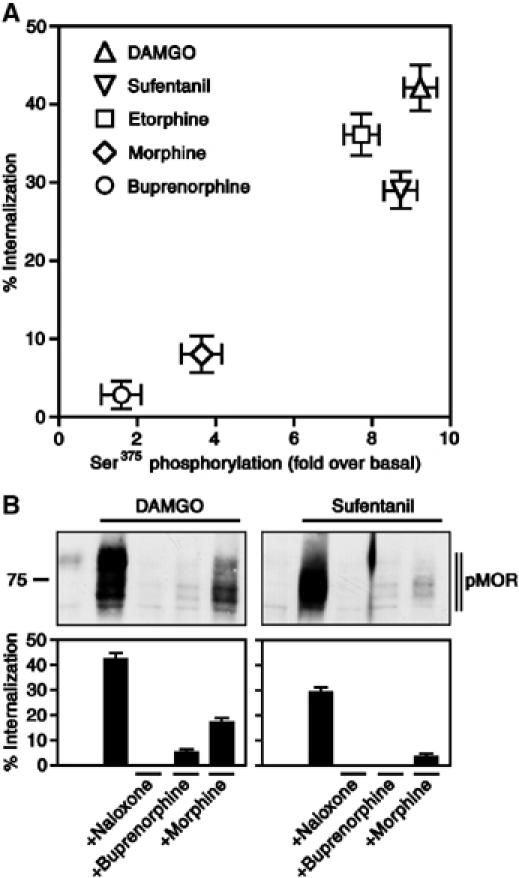Figure 4.

Partial agonistic properties of morphine. (A) HEK 293 cells expressing MOR were treated with saturating concentrations of DAMGO (10 μM), sufentanil (0.1 μM), etorphine (0.1 μM), morphine (10 μM) and buprenorphine (1 μM) for 30 min. For quantitative determination of receptor phosphorylation, cells were lysed and immunoblotted with an antibody specific for the Ser375-phosphorylated MOR. The levels of Ser375-phosphorylated MOR were quantified by densitometric analysis. Data were normalized to total MOR and expressed as the fold Ser375 phosphorylation over basal in untreated cells. Values represent means±s.e. of three to five independent experiments. For quantitative determination of receptor endocytosis, cell surface receptors were labeled with anti-HA antibodies, followed by a peroxidase-conjugated secondary antibody. Receptor sequestration, quantified as the percent loss of cell-surface receptors in agonist-treated cells, was measured by ELISA. Data are presented as mean±s.e. of three to five independent experiments performed in quadruplicate. Data for Ser375 phosphorylation and internalization were analyzed for correlation by the two-tailed Pearson test (r2=0.9057; P<0.05). Note, morphine was much less potent than the full agonists DAMGO, sufentanil and etorphine, but more potent than the partial agonist buprenorphine. (B) HEK 293 cells expressing MOR were treated with 10 μM DAMGO (left panel) or 0.1 μM sufentanil (right panel) in the presence or absence of 1 μM naloxone, 1 μM buprenorphine or 10 μM morphine for 30 min. For determination of receptor phosphorylation, cells were lysed and immunoblotted with an antibody specific for the Ser375-phosphorylated MOR (pMOR). The position of molecular mass marker is indicated on the left (in kDa). Three additional experiments gave similar results. For determination of receptor endocytosis, cell surface receptors were labeled with anti-HA antibodies followed by a peroxidase-conjugated secondary antibody. Receptor sequestration, quantified as the percent loss of cell-surface receptors in agonist-treated cells, was measured by ELISA. Data are presented as mean±s.e. of three independent experiments performed in quadruplicate. Note, morphine behaved like the partial agonist buprenorphine and potently inhibited both Ser375 phosphorylation and internalization of DAMGO- and sufentanil-activated MOR.
